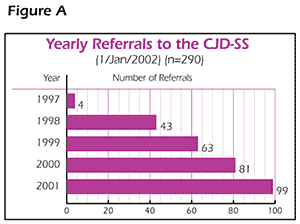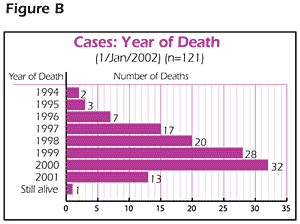Common menu bar links
Institutional links
Diseases & Conditions
Health & Safety
Research & Statistics
Agency Information
Search Box
E-mail this page
Creutzfeldt-Jakob Disease
Quick Links
CJD-Surveillance System
| Newsletters to Families | Newsletters to Physicians |
May 2002
PDF version ![]() (493 KB)
(493 KB)
[How to download PDF documents]
May 2002 Highlights
|
BULLETIN!!! Due to the recent use of new testing methods and techniques for 14-3-3 CSF protein analysis, we have noticed an increase in sensitivity of these techniques, resulting in a greater number of positive results. This phenomenon is being seen worldwide and is currently being assessed. It is therefore strongly recommended that the 14-3-3 protein analysis not be used as a screening test in the evaluation of Creutzfeldt-Jakob Disease patients, but rather as a test to be interpreted in conjunction with the overall clinical signs, symptoms and other investigations. |
CJD Surveillance System Update
As of 31 December 2001 we have had 290 referrals to CJD-SS (Creutzfeldt-Jakob
Disease Surveillance System) with 121 cases of definite (proven by pathology)
CJD. As reflected in figure A, there has been an ever
increasing number of referrals to the System since it's inception in 1998.
We believe this is attributable to the increasing public awareness of
this disease as well as the increased reporting by physicians to CJD-SS.
As seen in figure B, 1999 and 2000 are the years for
which we have the most complete data thus far. The incidence is 0.92 for
1999 and 1.04 for 2000. This incidence rate is comparable with international
incidence rates of 0.5 to 1/million of population. Of the 290 referrals
we have been able to obtain genetic sequencing on 86. As a result of this
information we have assisted in the diagnosis of 10 familial CJD cases
including six GSS. Since we began doing the 14-3-3 testing on CSF in our
laboratory in 1998 there have been 110 specimens processed. We feel we
have been effective in assisting physicians in diagnosing patients with
probable CJD. This successful recruitment rate for the CJD Surveillance
System is thanks to the overwhelming support from physicians caring for
patients with CJD as well as families affected by this devastating disease.


Classical CJD and Variant CJD: Similar names, different conditions
As there seems to be some difficulty with the diagnosis of CJD versus vCJD we have decided to highlight, in this issue, the differences between CJD and vCJD as they relate to signs, symptoms and investigations.
| Classical CJD | Variant CJD (vCJD) | |
| Age Range | onset 45 - 75 years of age | onset 12 - 74 years of age |
| Average Age | 60 years of age | 28 years of age |
| Average Duration | 4 - 6 months | 8 - 38 months |
| Symptoms (in order of progression) |
1 - rapid progressive dementia 2 - involuntary movements (myoclonus, chorea, dystonia) 3 - akinetic mutism 4 - extrapyramidal symptoms 5 - ataxia 6 - pyramidal signs 7 - cortical blindness |
1 - psychological symptoms (anxiety,
depression, withdrawal) 2 - ataxia (with persistent dysesthesia) 3 - involuntary movements (myoclonus, chorea, dystonia) 4 - dementia 5 - akinetic mutism |
| CT | cerebral/cerebellar atrophy | usually normal |
| MRI | putamen and caudate hyperintensity | bilateral pulvinar signal (77%) |
| CSF | normal | normal (can have high protein) |
| 14-3-3 (CSF) | positive (>80%) | positive (50%) |
| EEG | pseudoperiodic sharp waves (50-70%) | normal (or non-specific low waves) |
| DNA (at codon 129) | met/met 71% met/val 13% val/val 16% |
met/met 100% |
| Pathology - brain | Both classical and variant CJD: Spongiform changes,
neuronal loss, astrocytosis, protease resistant PrP |
|
| PrP amyloid plaques NOT seen | amyloid plaques | |
| Pathology - tonsil | normal | positive immuno-cytochemistry for PrPsc |
